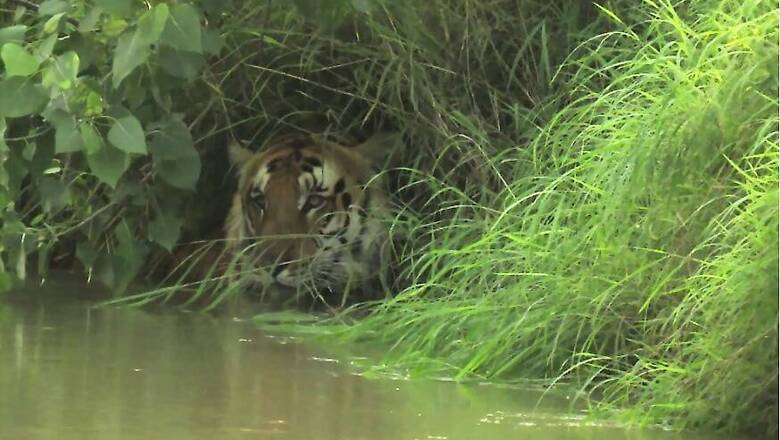
views
New Delhi: An adult male tiger that had strayed into a cane field in Lalpur from Pilibhit tiger reserve died on Sunday evening while it was getting treated for puncture wounds and maggots. It was tranquilized for the treatment. A detailed post-mortem will be conducted at the Indian Veterinary Research Institute (IVRI), Bareilly, on Monday, officials said.
On Sunday afternoon, the forest department received calls that a tiger was spotted in a cleared cane field in Lalpur. The same tiger had on Friday injured two villagers as it ventured out of the Mala range of the Pilibhit tiger reserve.
After they reached the spot, the forest department officials noticed injuries on the tiger’s neck and right flank. Based on this, the chief wildlife warden gave ‘speaking order to tranquilize the tiger to treat it’.
A team of UP forest department and two veterinarians of the animal husbandry department tranquilized the tiger in the evening around 5.15 pm, H Rajamohan, the field director of Pilibhit reserve said.
A veterinarian of the Wildlife Trust of India who provides additional support during such circumstances was also present. The animal husbandry veterinarians darted the tiger when it was in a shallow pool of water.
According to sources aware of preliminary assessment, the tiger had yellow canines indicating it was nearing the end of its prime years, it had three puncture wounds on the flank and shoulder and around 2cm deep with maggots.
Lalit Verma, the chief conservator of forest, Rohilkhand zone, said the tiger was sighted by villagers just 200-300m away from the spot where it nearly attacked a forest department team on Friday afternoon. “It was noticed using a camera that the tiger had injuries on its neck and there was a possible puss growth that needed treatment. The wounds could be due to a fight with another tiger or any other natural cause. It was tranquilized and it died during the course of treatment,” said Verma.
When asked whether central government’s protocol mandates tranquilizing an injured tiger for treatment, Verma said, “If an animal has wounds on its leg in the wild, the animals lick their wounds and they recover. But they cannot lick neck wounds. If we let it be, it might succumb to its injuries and since it came to our knowledge we went ahead. If it had been injured deep inside the forest we had not noticed, then it is another issue. But if we notice wounds and it seems sluggish, naturally we have to treat it.”
Responding to the same question on the need to tranquilize the animal, the state’s chief wildlife warden, Sunil Pandey, said, “From a distance it is difficult to ascertain whether the injury to the tiger is serious or not. This makes it important to assess it closely.”
Anup Nayak, member secretary, National Tiger Conservation Authority (NTCA), said, “If the state department has confirmed it is the same animal, which is frequenting a human dominated landscape, they might have reason enough to capture the animal. As per the standard operating procedure of NTCA, the chief wildlife warden has the final say. He is supposed to give a written order.”
In the Pilibhit case, the chief wildlife warden Sunil Pandey gave oral orders.
As per the NTCA’s 2013 standard operating procedure to deal with tigers found in human landscapes, in case a tiger occupies a sugarcane field or similar habitat, attempts have to be made to first attract it to a nearby forest area while avoiding disturbance. If such operations fail, the animal has to be captured through immobilisation for release in a low density area of the nearby tiger reserve.
Anish Andheria, CEO of the Wildlife Conservation Trust, asked how the forest department did not notice the wounds when it was under watch on Friday. “If there was a grievous injury that led to its death, why was it not considered serious enough on the day it was under watch initially? If the tiger is outside the forest, and for some reason the tiger is localized and the injury is visible, then there is pressure on the department from all quarters. People can take matters into their own hands. However, the injury should have been taken into account on day one,” Andheria said.
Pilibhit tiger reserve and the villages around it have often seen conflict between tigers and humans. Often, tigers from the reserve take refuge in the vast sugarcane fields surrounding it. Last year, angry villagers bludgeoned an adult tigress to death after it had attacked residents of Mataina village. In the same Terai region, another tigress was killed under a tractor near Dudhwa tiger reserve in November 2018.


















Comments
0 comment